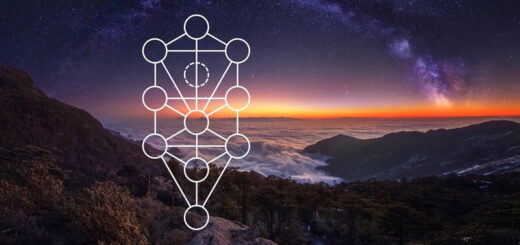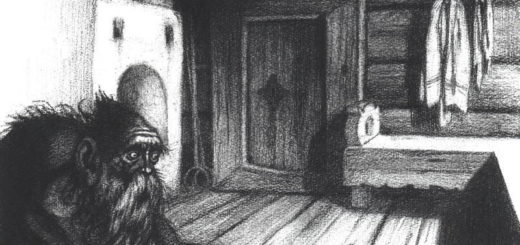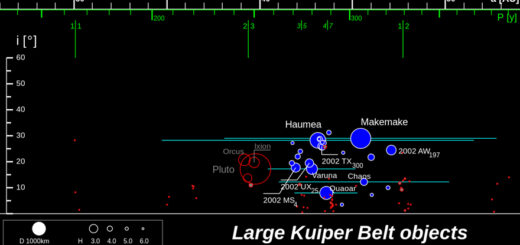The anatomy of the human being in the kabbalah
In kabbalah, it is believed that we are composed of different soul levels, each corresponding to a different aspect of the divine. Eight main components (condensation levels or subjectivities of the all-encompassing divine consciousness) make up our homeostasis. That is, each individual component is related to and resonates with the other components. When one component is weak or out of balance it affects all the others. Conversely, when one component is very strong and healthy it also affects all other components.

The human soul in the Kabbalah is a homeostasis of eight interrelated segments.
Some components are personal, others semi-personal and others basically impersonal, but personalize in relation to the personal components. The eight different soul levels are represented by the following terms:
1. the Guph (physical body).
This is your biological living body. It was given its form by the hereditary material of your ancestors and parents, your birth chart and is subject to interactions with the environment and your diet and lifestyle. What keeps your body alive in a direct sense are the Nefesh (etheric double) and the Chayah (Life field itself). Horoscopically, the Guph is strongly connected to your ascendant and its planetary ruler, your Sun and your Moon.
2. the Tzelem or Tselem
The Tzelem is your etheric double, a field that occupies the same space as your physical body and protrudes slightly from it. The size and density of the Tzelem is determined by your amount of energy. The more energy, the more dense it becomes and the further it protrudes from your skin.
In anxiety, lethargy and depression, the energy field (made up of qi/mana/od/orgone energy) retracts inward, lowering your resistance and making you feel cold. With enthusiasm, happiness, positive assertiveness and creativity, it becomes stronger and steps out more. The physical body feels warm, fit and stable.
The Tzelem is the only connection between your physical body on the one hand and your astral and mental body on the other. The Chayah also works through the Tzelem. As the “Tzelem anatomy,” the Tzelem houses all your meridians, chakras, acupuncture/pressure points and reflex zones. Your endocrine glands form a bridge between the Tzelem and your physical body, while your Tzelem an sich, as a whole is the connection between your physical body and your Nefesh. The Tzelem can contain entities and larvae.
The Hebrew term צֶלֶם tzelem, tzeh’-lem; from an unused root meaning shadow; a phantom, i.e. (figuratively) illusion, likeness. The term also sometimes refers to a “representative figure,” especially an idol, statue/image general or, vain display. Hence the Tzelem, where this term is meant to describe a component of the human being is also referred to as Tzelem Elokim (the image of God; God’s image as a “mold” for the human form – referring to God created man as His image). The Tzelem can sometimes be partially projected from the body and travel outside it and be seen by sensitive people. This art was especially peculiar to Lapland shamans.
3. The Nefesh
The Nefesh is what is called the “animal or animal soul.” It is the mind of all biological instincts and reflexes. The Nefesh houses social consciousness, the survival instinct, empathy and empathy with other life, the reproductive and sexual instincts and drives, your reflexes and emotional intelligence.
The Hebrew word root NPhSh (Nun Phe Shin) or NFS means to breathe, to breathe, to breathe, to expand and through Egyptian has a relationship to the lungs. Nefesh is usually translated as “soul” or “Living soul”. “Breathing, living soul,” is the most correct translation here.
The Nefesh is strongly connected to nature, the Earth, life itself, the Shekhinah (the immanence of the divine/goddess in the world). The Nefesh further connects as an intermediary all other components of your being. Western occult tradition usually designates what in kabbalah is called Nefesh with astral body and on the feeling body. In invocations, the Nefesh can be temporarily taken over by a spirit of, e.g., a deceased or nature spirit, Lwa, or the like.
4. The Ruach
Ruach literally means wind or spirit (also in the sense of a discarnate spirit). The Western occult tradition usually designates what in kabbalah is called Ruach with mental body. In the Ruach houses your thinking, your ability to contemplate, your thinking frames, your reflexion, all your cognitions and cognitive abilities and in correlation and interaction with your Nefesh, Tzelem and Guph also your imagination and focusing power.
The Ruach along with the other bodies can hold your life course and be creative in a positive sense. In a negative sense it can house all kinds of engrams, traumata, destructive indoctrinations, thought frames or obsessions that eat up your energy and stop or slow down your development, addictions, etc.
In invocations that allow a third degree possession, the Ruach, like the Nefesh, can be temporarily taken over by a spirit of e.g. a deceased or nature spirit, Lwa, or the like. Within African-American religions this happens very frequently and people communicate in this way with deceased ancestors, who always keep an energetic connection with you and who ask for a harmonious understanding and respect. In many non-Western cultures, people know that the latter is essential to their own health and prowess in life.
5. Neshamah
Wilhelm Gesenius’ Hebräisches und Aramäisches Handworterbuch über das Alte Testament (1890) gives as explanations for the term Neshamah.
a. gust of wind or airflow. Especially of a cold wind.
b. of the breath of wrath, the snuffling of God the Judge.
c. the animating, inspiring breath of God the Creator, breath, the life principle of the human body.
Usually option c. is taken when explaining what the Neshamah is, only this explanation says little, when Nefesh and Ruach mean approximately the same thing and are also in the connotation of breath, breath of life, wind, airflow etc. The terms inspirational, inspiring take us a little further. These link the Neshamah to enthusiasm and what in the Tao is called shen-qi (spiritual energy). From this context, the Ruach could then be associated with (inhaled through the lungs) qi in a general sense and the Nefesh and Tzelem linked to jing-qi (physical, hereditary, sexual qi) as being the most condensed form of qi.
I would prefer to translate the Neshamah within the overall thrust of the terms used here to describe the components of the human being and soul anatomy, as the “higher self” or better yet “the somebody” (I am somebody who…). Indeed, the Neshamah marks the part of the soul that resides between the personal components (Guph, Tzelem, Nephesh, Ruach) with the transpersonal components Chayah, Yechidah, Adam Kadmon that belong to the realm of the collective and all-encompassing. When we sit with an unsolved problem or issue and sleep on it overnight, we often wake up with the answer. It is then the Neshamah that has then acted as an intermediary between the personal and transpersonal parts of the soul at the time our waking consciousness was switched off.
6. Chayah
The Semitic word root חיה has a relationship with both “contraction” and “life,” with life usually in the sense of “real life,” “exuberant life.” The Chayah is a collective and transpersonal part of our system and represents the life field that gives life to all organic life forms. The link of Chayah to contraction can be speculatively explained as a condition for life in the Lurianic kabbalistic sense, where creation and life arises through the tzimtzum, the supreme being who by contraction makes the space for creation and life (the spirit, the ideas for beings condenses into the material dimension).
Chayah contains the intelligence of life and its organization. It is the co-intelligence that is always present, right from conception. The Chayah makes the embryo grow into an adult being, sets the clock for the life span of each being, regulates all unconscious physiological processes such as heart rate, respiration, oxygen intake, metabolism, etc.
The Chayah of one human being can further resonate with that of another human being; in a group of women living together in close contact, normally within a few months their menstrual cycles begin to synchronize. People with very close relationships, often sense when something serious physical is going on with a remote partner, even if they are on the other side of the world. The Chayah also connects us with other life, with plants, animals, nature in general.
In our time, within a larger process (an accelerated advance, due to the current technological status, of inorganic life into our realm of organic life) the Chayah has become a battleground, in which the natural and organic must fend off things like mRNA vaccines, microwave radiation, chemical contamination of food, water and air, and GMO crops.
There is a process going on that wants to make organic life inorganic. Transhumanists are very open about this. Spiritually, this would have colossal consequences, amounting to a psychecide, a massive soul murder or disconnection of man from life itself with its evolutions linked to reflexion, which would then be exchanged for a dead, numb, sec functional reflex event.
The collective energy/intelligence of the Chayah personifies itself in us through the Tzelem and the Nefesh, with the Tzelem and Nefesh of each living being in turn linking the Chayah to matter, thus providing the Chayah’s (life’s) aspirations the bouquet of forms, variations and biological interactions.
7. Yechidah

Christian Ginsburg, The Kabbalah – its Doctrines, Development & Literature
The Yechidah is the collective intelligence and consciousness field (which with this automatically includes the so-called “collective unconscious” from Western psychology). Without Yechidah, there was no lateral intelligence, no intuition, no inspiration. The Yechidah links Adam Kadmon, the fractal of total all-encompassing, all-flowing consciousness, through the intelligence of life to the personal parts of our souls. The Hebrew word root from which Yechidah is derived יחד means to connect, to bring together, to join. Because the Yechidah connects Adam Kadmon, the archetypal “Mensch” (who has not yet been deformed by indoctrinations and obsessions) to the field of living man, this soul layer is associated with “divine insight” or in ancient Greek terminology the Zoê Noêsis (intuitive holistic knowing). Nowadays that “divine insight” is rarely achieved through theurgy, but mostly with magic mushrooms, LSD, ayahuasca, DMT and the like.
8. Adam Qadmon or Adam Kadmon
This is the primal model or archetype of man. It is the anthropomorphic representation of what in Tantra is the Atman or god spark. Adam Qadmon is usually translated as Original Man. This translation is substantively correct, although qadmon literally means “eastern,” as opposed to qadmah (original, previous state).
Adam Kadmon is to be understood as a human being (Mensch in Yiddish). Adam Kadmon is the inner watchman within us who can make conscious of an indoctrination, an obsession an imposed or self-developed compulsion pattern, an entity contamination or ethereal storm, societal norms that become inhuman and lead us out of them. The latter usually requires a rigorous approach and strategy, but Adam Kadmon is the one who says, Ho, wait a minute, something is wrong here! Adam Kadmon is the bare operating system at the intersection of the “deity” of God and the “people” of man.
To remain human, we need Adam Kadmon as the very first frame of reference. It contains the qualities that make man, human and an animated living being. Like the Chayah, this part of our soul and being makeup is under great pressure when a societal system seeks to suppress or eliminate these human qualities with a sec arbitrary and imposed only through quantification techniques, which serves the ruling elite for the empowerment of some screwed-up obsession. This mechanism always occurs when things go wrong on a large scale in a society and dehumanization rears its head again.
You may also like to read:
Dybbuk or Dibbuk – the sticky ghost of the Ashkenazi
Pulsa diNura the Jewish Fatal Curse
Jewish Necromancy
Jewish Femmes Fatales for Dummies
Spirit Beings in European Folklore
Lares, Lemures and Penates
The real vampire in Russia and Slavonian countries






